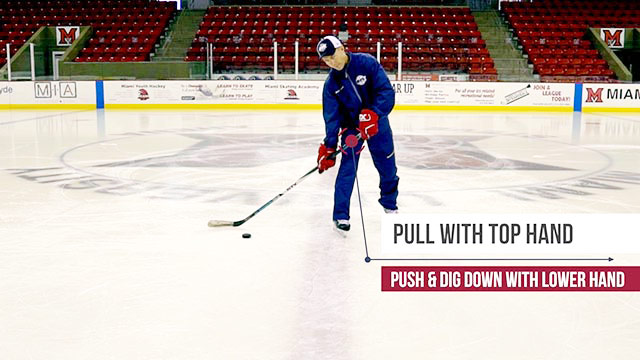Finnish 5 Puck Progression

In this video, Ben Eaves explains a hockey activity and progression that is excellent for every age and skill level. The activity can be done with 3, 4 or 5 players at a time. The video above shows two groups going through the progression. Group # 1 consists of 4, U18 players and Group # 2 is made up of 5, U10 & U12 players.
The major concept of the Finnish 5 Puck is to practice dynamic decision making which will help players learn to play with their head up instead of staring at the puck while they work to memorize a drill. The initial activities are set up to warm up your hands and edges. From there, the activities become more complex as more decisions need to be made within the group. Each Activity encourages players to keep their head up, move to open space, and pass the puck by interacting with their teammates through verbal & non-verbal communication.
If you commit to working on activities like this instead of memorization drills for a portion of each practice, you will marvel at how your team begins to work together. It will look extremely messy at first, but players will get better with each repetition. Moving to open space, and moving the puck will eventually become second nature to the team.
SETUP & ACTIVITY VARIABLES
- Players: great for 3, 4 or 5 players at a time.
- Time: You can rotate through groups of players in 45 - 60 second shifts. 5 players can be participating in the activity, while another 5 rest. Blow the whistle and the next 5 jump in.
- Space: can be set up to be within a zone, or half of a zone (station) or a smaller area. The smaller the space, the more challenging it will be for the players as they are forced to make quicker decisions.
- Added Challenge: add obstacles within the space to challenge the players further. Tires, cones, sticks, etc placed in the space make it harder to pass and skate around. As time goes on the added obstacles will help improve their reaction & decision making.
Activity # 1: Forward Skating
The goal of this activity is to get players warmed up and comfortable with skating forward to open space with the puck. They should be keeping their head up so they do not run into anyone or any obstacles that are out in the playing area. Players can work on their edges, control turns, mohawk turns, dekes, changing pace and whatever their creative minds (and coaches) can think of!
Activity # 2: Backward Skating
The goal of this second activity is to get players comfortable with skating backwards with the puck to open space. Since players are skating backward, it is crucial that all players keep their head up and look over their shoulders at all times.
Activity # 3: Forehand Only Puck Control
In this activity, players can only stickhandle with their forehand. This encourages players to move their body around the puck. This will help with puck protection along with changing passing and shooting angles. Continue to encourage players to keep head up and move to open space!
Activity # 4: Pass 1 Puck
Now that everyone is warmed up, this is where the fun begins. Encourage players to use verbal and non-verbal communication to pass 1 puck around between the group of players in the activity. Do not let players stand still and pass back and forth. Call out for constant movement and to skate to open space. When players receive the puck, they should take a stride or two, have their head up, and make a pass to an open teammate.
Activity # 5: Pass 2 Pucks
Here we go! With two pucks it is even more critical to keep your head up and communicate. It is important for all players to have an idea of where both pucks are so they can be ready to receive a pass and be ready to make a pass without passing to someone who already has a puck.
Activity # 6: Pass 3 Pucks
With three pucks it is important to read your teammates and anticipate what they are going to do with the puck. If you don't pay attention, you end up receiving a pass you are not ready for, or you pass to someone who isn't looking. Communicate verbally, pay close attention and read body language!
Activity # 7: Pass 4 Pucks
This could be the hardest of all of the activities. It is important to stress patience with the puck in this round. If players do not pay attention they end up all passing to the one open player at once. Keep your head up, be patient and pass when your teammate is ready to receive your pass. Do not rush. If you are the only player without a puck, make it clear with verbal communication who you want the puck from.
Activity # 8: Pass 5 Pucks
With 5 pucks (or 4 pucks with 4 people) it is important to communicate with eye contact and verbal queues. Do not attempt rink-wide or long passes at first. Short and subtle drop passes and slides work excellent in this activity.
Activity # 9: 4 vs 1
Now that everyone has been challenged with passing multiple pucks, it should be extremely easy to pass one puck and keep it away from a defender. Use all of the lessons learned above (moving to space, verbal and non-verbal communication) to make sure that the defender does not have a chance to touch the puck.
Activity # 10: 3 vs 2
3 on 2 will be an increasing challenge to play keep away, but with patience, puck protection and communication, the defenders should still not be able to get the puck.
Added Competitive Challenge:
- Group Challenge: After the group gets comfortable with the exercises, you can add a natural element of competition between the groups by counting the number of successful passes made in the passing activities. Or you can count the number of successful passes made in a row. Either of these can be a fun way to get each group to work harder by having them compete with each other and focus on getting open and making a good pass.
- With a Goalie: when you are playing 4 on 1 or 3 on 2, if the team makes 5 passes in a row you can allow them to shoot on a goalie.
Coaching Points:
- Encourage players to always move to open space on the ice. Do not allow them to stand still and pass the puck back and forth.
- Encourage verbal communication (calling teammate by name, saying you are open, etc).
- Encourage non-verbal communication (good eye contact, showing a passing target, tapping a stick, etc).
- Allow players to make mistakes. It will take time to get comfortable with these activities. But as time goes on you will see them picking their head up to make a decision, which is the goal of this progression.
If you are interested in more hockey activities which require more decision making, reading, and reacting then please check out this article which discusses 11 Activities for Youth Hockey Practice.








Stickhandling and Passing
Great drill to teach moving to space and heads up passing.